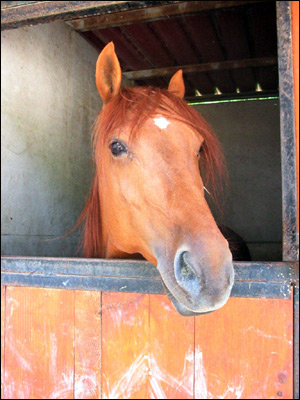|
Nestled in the mountains of the Marche region of Italy, Cantiano
is home to many woodland and natural food products and regional
specialties.
One such delicacy is la carne di cavallo, or horsemeat.
The meat, unlike other meat delicacies, is not typically associated
with special holidays or traditional events. It is consumed
on a regular and informal basis. The production and eating
of horsemeat, which is as popular as other meats and fish
in Le Marche, has a rich and varied history.
“The tradition of eating puledri, or young
horses, is centuries old,” said Eva Ceccarini, the butcher
and owner of Carni Equine, a specialty butcher shop
located in Cantiano. “The horses are only raised to
about 14 months of age.”
|
|
|
|
|
|
Catria horses originally populated the land near Cantiano
and were named for the nearby Catria Mountains.
Ceccarini said that she has been working at Carni Equine
since she bought the business just over a quarter century
ago.
“My family did not have anything to do with horsemeat
until I bought this shop from a man who had given up,”
she said. “I passed the exam to get a special amendment
to my butcher’s license and have been here ever since.”
The meat found at Carni Equine as well as in other
butcher shops in the Urbino-Pesaro province originally came
from the Chiaserna, a town near Cantiano, and horsement production
has since extended to Gubbio, Cagli and Fano.
Horsemeat has the same traditional cuts as other meats, and
it has a texture similar to veal — because of its age
and the similarity between the muscle fibers.
“Horsemeat is comparable in price to any other meat,”
Ceccarini said. “You will find it on dinner tables just
as frequently as you would chicken or beef.”
Much like beef, the best cut of meat from the horse is the
steak, which is cut from the thigh with the bone attached.
|
|
|
At Carni Equine, as in other butcher
shops, the meat arrives already separated into cuts and ready
to be sold. In this region, most of the butchering and distribution
of horsemeat occurs in nearby Cagli. The pieces are sent out
weekly to the various venues in the region to ensure freshness.
“They deliver all cuts of meat each week,” she
said. “I select the best cuts to be sold here at my
macelleria.”
Ribs, steak, sausage, roast, and ground meat are all readily
available under the cool glass case at Carni Equine
365 days a year.
“One of the best things about the meat is that it is
not seasonal, and since the horses are raised and kept indoors,
it always available and it’s always fresh to the shop,”
said Ceccarini.
Additionally, horsemeat is a major source of nutritional value.
Though the specific nutrients differ from other meats, horsemeat
is lean with almost no fat at all. Additionally, it has no
cholesterol, which makes it appealing to those who have a
passion for red meat and consume it on a regular basis.
However, it does require seasoning because the meat is much
more delicate than beef or veal. By nature it has a sweet
taste and a soft texture.
|
|
|
|
|
“The
meat is popular because it is also very digestible,”
Ceccarini said.
“I prefer to buy it and cook it at home,” said
Normano Gaeta, a zoologist and expert on Catria horses. “However,
I do like they way they prepare it at restaurants, although
there are only two locations that serve the delicacy in the
area.”
In recent years the traditional recipes and ways to prepare
horsemeat have spread out from Cantiano to other locales within
the Marche region. Two restaurants in the area that are known
for their horsemeat or puledri dishes are La
Trattoria del Sole in Cantiano and the newly-opened Restaurante
del Commercio in Cagli. Both businesses get the meat
that is featured on their menus from Carni Equine
on a weekly basis.
|
|
|
|
“The meat was not originally intended to be consumed
in the large way it is today,” said Gaeta. “Originally,
the meat was prescribed by doctors to those with anemia. Now
hundreds of years later you can order it off of a menu.”
Furthermore, in Cagli, many other restaurants use horsemeat
as an ingredient in the salamis and sausages served in their
antipasti.
Although the delicacy is gaining popularity in Italy and
throughout Europe, many people are still reluctant to engage
cavallo, the other red meat.
“Though horsemeat is known worldwide, the meat of the
Catria horses is only popular in this area,” said Gaeta.
“Just imagine how popular it would be if America got
a hold of it.”
|
|
 \ \ |
|
|
|
|
|

